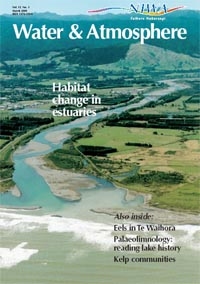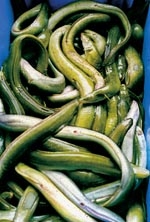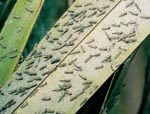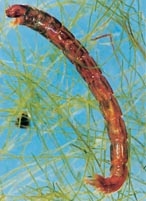PDF of this article (573 KB)

Dave Kelly Don Jellyman
What is causing slow growth of young shortfin eels in Te Waihora?

Te Waihora (Lake Ellesmere) is one of the largest lakes in New Zealand and has long been recognised as a valuable fishery and wildlife resource. There are large populations of waterfowl, as well as eels and flounder. Shortfin eels (Anguilla australis) in Te Waihora form an important traditional Maori and commercial fishery.
Recently, however, concern has been expressed about the eel fishery in Te Waihora, especially in relation to possible declining water quality in the lake.
Within living memory, the lake margins have had clear water and wide stands of aquatic plants. Up until the 1960s, this vegetation diminished from time to time because of storms and changes in water clarity, but always grew again. But following the “Wahine storm” in 1968 almost all the plants were lost, and have not returned to any great extent. Since then the entire lake has been turbid.
It is still unclear how these changes have affected the ecology and fisheries of Te Waihora. But we do know that juvenile shortfin eels seem to grow very slowly there, and in some years very few young eels join the population.
Because Te Waihora is not always open to the sea, variations in the numbers of eels of a certain age are probably related to both the timing and duration of lake openings. The slow growth rates are more difficult to explain. However, a recent study on food-web dynamics in Te Waihora has come up with some potential explanations for the change.
Who is eating what?


We investigated the food web in Te Waihora using stable isotope analysis. The technique allows us to identify who is eating what in a given ecosystem. Data on stable isotope ratios are usually supported by information on the diets of animals higher in the food chain, obtained from analysis of gut contents.
Gut content data alone are not always a good indication of energy transfer through a food web. They tell us only what an animal has just eaten, and some things can pass through animal guts undigested. Stable isotope information, on the other hand, reflects what the animal has actually digested over longer periods (several months).
We carried out stable isotope analysis on a range of organisms from Te Waihora, along with gut content analysis of fish. Some interesting results emerged.
The food web in Te Waihora is based on phytoplankton and benthic (bottom-dwelling) or epiphytic (growing on another plant) algae from the lake itself. This is typical of many New Zealand lakes and contrasts with river systems, where inputs from land plants can be important at the base of the food web. Constant disturbance of the sediment by winds made it difficult to distinguish between the isotope signatures of algae growing on the sediment surface and planktonic algae, so we couldn’t determine which was more important in the food web. As a result isotope analysis alone did not indicate clearly the importance of different prey items as food for fish.
Gut content analyses agreed well with the isotope results from shortfin eels. The isotope signatures of small eels (100–300 mm) suggested that they were eating larvae of the chironomid midge Chironomus zelandicus, oligochaetes (worms) or copepods (tiny crustaceans). In fact, their guts were full of chironomids. The results for mid-sized eels (300–400 mm) indicated that they were eating bullies and/or the mysid shrimp Tenagomysis. Gut content analyses confirmed that bullies were most important. Isotope signatures of large eels (>400 mm) suggested a diet of a combination of bullies, mysids, smelt, and possibly small eels.
The isotope analyses showed that the diets of common bullies and small eels were probably very similar.
Changes from the past
A report on the diet of shortfinned eels in Te Waihora in the 1970s stated that the snail Potamoprygus antipodarum was the most important food for juvenile eels. In our study snails did not feature in the diet of eels of any size. In addition, surveys of invertebrates showed that snails are now quite rare in the lake. It is possible that the decline in plant growth along the lake’s margin since the end of the 1960s has meant a decline in P. antipodarum, as these snails are often very common on aquatic plants. Unfortunately, there are no historical data on invertebrates in Te Waihora to confirm any of this. Nevertheless, from our results, it seems very probable that midge larvae have replaced snails in the diet of smaller eels, while larger eels have switched to eating fish.
We think that the slow growth rates of small eels are a result of competition with common bullies for the same main prey – midge larvae. Indeed, some earlier work has already suggested that the large numbers of bullies living in the lake in recent times could be competing with small eels. Bullies can spawn in fresh water and can respond rapidly to changes in the amount of food available. For example, in years when midge larvae are plentiful, they could spawn more than once. Any such increase in bully numbers could reduce the feeding opportunities for small eels. However, once eels become large enough to eat bullies, there is plenty of food available, and this shows in the faster growth of larger eels.
Overall, our findings indicate the pivotal importance of Chironomus zealandicus in sustaining the fish populations of the lake. Numbers of Chironomus, as evidenced by swarms of adult midges, appear to fluctuate widely from year to year and, at this stage, we know little about why their numbers vary so much. This highlights the need for future work aimed at understanding the ecological factors that control midge population dynamics in Te Waihora.
Teachers: this article can be used for NCEA Achievement Standards in Biology (1.4, 2.2, 2.5, 3.4), Science (1.2, 2.2, 2.3), Chemistry (1.2, 1.5). See other curriculum connections at www.niwa.co.nz/pubs/wa/resources
Dave Kelly and Don Jellyman are based at NIWA in Christchurch.

Stable isotopes for studying food webs
Measurement of naturally occurring stable isotopes in plants and animals is a useful tool for investigating the flow of energy through food webs. This technique involves measuring ratios of different forms (or isotopes) of carbon (13C:12C) and nitrogen (15N:14N) in the tissues of plants, animals and other materials (e.g., sediment, detritus, and wood) to determine “who eats what” in a particular system. Once carbon (as CO2) and nitrogen (typically as NO3 or NH4) are fixed by plants, the isotopic ratios are passed on to primary, secondary and tertiary consumers in a predictable manner, with slight enrichments in the heavier isotopes upon each transfer.
The isotopic signatures of the different foods available to consumers – such as phytoplankton, aquatic plants, and terrestrial plant matter – are usually distinctive because of differences in photosynthetic pathways used by differing types of plants. For more on stable isotope measurement, and uses of the technique, see past Water & Atmosphere articles: Sulfur isotope signatures; Declining rockhopper penguin populations.
Te Waihora: some facts
Te Waihora is a large, shallow (~ 2 m), highly exposed coastal lagoon located along the southern edge of Banks Peninsula in Canterbury. Te Waihora is the largest coastal lagoon in New Zealand, and can be as large as 30,000 hectares, depending on its water level, which is controlled by an opening to the sea along Kaitorete Spit at its south-west border. Historically, Te Waihora flooded vast areas around Haswell to as far as Christchurch; however, the lake is now manually opened each year (usually in spring) to prevent flooding of adjacent land. The lake is considered to be one of New Zealand’s most important wetland systems and is now protected by a Water Conservation Order, mainly in recognition of its wildlife values.
Further reading
Jellyman, D.J.; Todd, P.R. (1998). Why are migrating male shortfinned eels (Anguilla australis) in Lake Ellesmere, New Zealand, getting smaller but not younger? Bulletin Francais de la Peche et de la Pisciculture 349: 141–152.
Ryan, P.A. (1986). Seasonal and size-related changes in the food of the shortfinned eel, Anguilla australis, in Lake Ellesmere, Canterbury, New Zealand. Environmental Biology of Fishes 15: 47–58.
